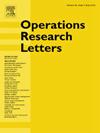几何缩放的复杂性
IF 0.9
4区 管理学
Q4 OPERATIONS RESEARCH & MANAGEMENT SCIENCE
引用次数: 0
摘要
几何尺度由Schulz和Weismantel于2002年引入,通过原增广解决了整数优化问题max (c⋅x:x∈P∩Zn),其中P∧Rn是一个多面体。我们只考虑P是0/1多面体的情况。Schulz和Weismantel表明,不需要超过O(nlog2 ln n‖c‖∞)对增强oracle的调用。使用Le Bodic, Pavelka, Pfetsch和Pokutta在2018年提出的早期停止策略,可以将该上界改进为O(nlog2²‖c‖∞)。考虑到该方法的最大比例增广变体及其近似版本,我们证明了这些上界本质上是紧的,通过在一个n维单纯形上最大化向量c,使得‖c‖∞为n或2n。本文章由计算机程序翻译,如有差异,请以英文原文为准。
The complexity of geometric scaling
Geometric scaling, introduced by Schulz and Weismantel in 2002, solves the integer optimization problem by means of primal augmentations, where is a polytope. We restrict ourselves to the important case when P is a 0/1-polytope. Schulz and Weismantel showed that no more than calls to an augmentation oracle are required. This upper bound can be improved to using the early-stopping policy proposed in 2018 by Le Bodic, Pavelka, Pfetsch, and Pokutta. Considering both the maximum ratio augmentation variant of the method as well as its approximate version, we show that these upper bounds are essentially tight by maximizing over a n-dimensional simplex with vectors c such that is either n or .
求助全文
通过发布文献求助,成功后即可免费获取论文全文。
去求助
来源期刊

Operations Research Letters
管理科学-运筹学与管理科学
CiteScore
2.10
自引率
9.10%
发文量
111
审稿时长
83 days
期刊介绍:
Operations Research Letters is committed to the rapid review and fast publication of short articles on all aspects of operations research and analytics. Apart from a limitation to eight journal pages, quality, originality, relevance and clarity are the only criteria for selecting the papers to be published. ORL covers the broad field of optimization, stochastic models and game theory. Specific areas of interest include networks, routing, location, queueing, scheduling, inventory, reliability, and financial engineering. We wish to explore interfaces with other fields such as life sciences and health care, artificial intelligence and machine learning, energy distribution, and computational social sciences and humanities. Our traditional strength is in methodology, including theory, modelling, algorithms and computational studies. We also welcome novel applications and concise literature reviews.
 求助内容:
求助内容: 应助结果提醒方式:
应助结果提醒方式:


